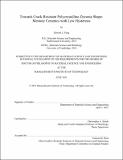Towards Crack-Resistant Polycrystalline Zirconia Shape-Memory Ceramics with Low Hysteresis
Author(s)
Pang, Edward L.
DownloadThesis PDF (52.43Mb)
Advisor
Schuh, Christopher A.
Terms of use
Metadata
Show full item recordAbstract
A new class of shape memory materials has been proposed based on zirconia-based ceramics, which offer higher work output, transformation temperatures, and possibly environmental resistance compared to metallic shape-memory alloys. Despite these potential benefits, two shortcomings have prevented these materials from reaching their full potential: i) polycrystals catastrophically crack during the martensitic transformation, and ii) the transformation exhibits a large hysteresis of over 150 K. It is yet unknown what drives these phenomena and how they can be avoided. In this thesis, these phenomena are systematically investigated in a series of ceriadoped zirconia compositions. Using in situ X-ray diffraction, transformation mismatch strains are characterized and subsequently correlated with observations of cracking during cycling experiments and measurements of thermal hysteresis by calorimetry. These findings demonstrate for the first time the importance of interface compatibility on transformation-induced cracking and reveal that special compositions with optimized compatibility can largely avoid transformation cracking even in polycrystal form. Specimens with reduced cracking, however, show transformation suppression, and a comparative study between polycrystalline pellets and oligocrystalline powders has elucidated the effect of grain constraint on transformation behavior. In addition, a mechanistic understanding of thermal hysteresis in these materials is established using martensite nucleation theory, which reveals that the same controlling factors as in shape-memory alloys, namely interface compatibility and thermal friction, are also operative in zirconia shape-memory ceramics, although here thermal friction has been attributed to Peierls barrier controlled interfacial glide. Using this newfound understanding, a set of design criteria is outlined to obtain reduced cracking, complete transformation, and low hysteresis in a polycrystalline specimen. Using computational materials design techniques, novel zirconia compositions are designed and experimentally tested. Although not all criteria were met, a pseudo-ternary prototype demonstrated improved cracking resistance with a reduced hysteresis of only 75 K. Together, these studies aid our understanding of martensitic transformation in polycrystalline zirconia shape-memory ceramics and pave the way towards tunable and repeatable shape memory and superelastic behavior in these emerging materials.
Date issued
2021-06Department
Massachusetts Institute of Technology. Department of Materials Science and EngineeringPublisher
Massachusetts Institute of Technology